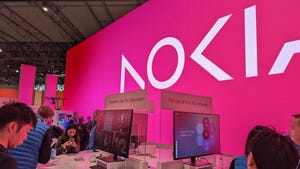It’s all about the network APIs at Network X 2024It’s all about the network APIs at Network X 2024
Telecoms trade show Network X focused on the opportunities promised by massively improved network exposure on its opening morning of keynotes this year.
October 8, 2024

The session was opened by Alexandra Dublanche, whose job is to foster economic development and innovation in the Paris region, where Network X has been located for the past couple of years. Inevitably AI was a major theme, but Dublanche rightly stressed the need to balance a zealous embrace of the possibilities offered by AI with the significant ethical dilemmas inherent in its development.
We then heard from Omdia Analyst Dario Talmesio, who was determined to look on the bright side of life, when it comes to the global telecoms industry. We were told that, since 2020, global connectivity revenue has been growing, albeit very slowly and certainly below the rate of inflation. This was contrasted with declines prior to that. It should also be noted that most of that growth has been generated by the fixed-line sector.
So how are we going to increase that growth at a time of steadily declining ARPUs (average revenue per user)? This is where the keynote session established its core trajectory and the answer is through APIs enabling network exposure to third parties, of course. But the thing is, Omdia forecasts total annual global revenues from network APIs hitting around $9 billion by 2029. That’s five years away and doesn’t amount to much per operator.
Nonetheless, Talmesio stuck gamely to his glass-half-full narrative and concluded by stating: “The telecoms industry is looking much better than it did five years ago.” Interpret that as you will.
Next up was one of the main cheerleaders of the recently announced joint venture designed to accelerate and scale this network API bright idea, Peter Arbitter, SVP of Magenta Business API at Deutsche Telekom. He started by noting that much of the API action is currently in the hands of CPaaS (communications platform as a service) players and inferred that it would be nice if the operators themselves did it instead.
One of the challenges exponents of network APIs face is proposing tangible, revenue-generating use-cases. Arbitter spoke of a theoretical retailer who, thanks to APIs is able to know loads about every customer that comes into the shop and, presumably, bombard them with an array of products certain to appeal. Leaving aside privacy questions this use-case raises, it still wasn’t obvious what new revenue opportunities this would present to operators.
Arbitter also addressed the structure and management of the new JV, in which Ericsson has an outsized role thanks to its contribution of the expensively acquired Vonage. His perspective is that the structure will enable speed and agility, qualities not often associated with the telecoms industry. “This is not an exclusive club, we were just the ones that got it started and we’re inviting everyone to join,” he concluded.
The morning session concluded with a panel discussion on, you guessed it, APIs (pictured above). It was characterised by differing perspectives on the matter between Arbitter and Gabriela Styf Sjöman, MD of Research and Networks Strategy at BT Group, with the latter acting as a foil to the former’s API evangelising.
“Are telcos just the enablers of service innovation or do they participate in it?” said Styf Sjöman, warning that if all operators do, once more, is create the communications platform for other companies to mainly profit from, then it will be hard to view this initiative, which she characterised as an ‘aggregator’ as a success. The emotional scar tissue generated by missing out on most of the commercial opportunities generate by mobile broadband is still fresh for operators.
Arbitter politely pushed back on some of this but Styf Sjöman was undeterred from her theme. “APIs are a means to an end,” she continued. “We’re more focused on what their impact is on the platform play, use-cases and making the network much more attractive to our users.” The third panellist, Otilia Anton, Program Director of Telco APIs at Orange, appeared to concur. “That telcos don’t really understand our customers’ customers is nothing new,” she said.
In other words, it’s going to take a lot more than just a network API aggregator for operators to fully understand, embrace, and exploit the new commercial channels it needs to find in order to restore healthy growth – i.e B2B and B2B2C. Arbitter, sounding slightly defensive by this point, concluded by stressing that a major purpose of this new JV is to help evolve operator corporate culture in that direction.
Just as we discussed in our most recent podcast, the concepts behind this major industry initiative remain somewhat abstract and intangible. Around half of the expected network exposure use-cases revolve around digital ID and fraud prevention, sectors that are already well established. While it’s clear that much of the industry is all-in on APIs, it feels like we’re still a few Network X keynotes away from being able to get really excited about them.
About the Author
You May Also Like










.png?width=300&auto=webp&quality=80&disable=upscale)


_1.jpg?width=300&auto=webp&quality=80&disable=upscale)